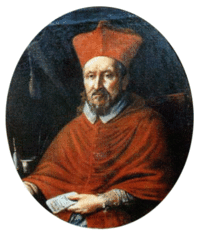Caterina Ginnasi
| Caterina Ginnasi | |
|---|---|
| Born |
1590 Rome |
| Died |
November 30, 1660 Rome |
| Nationality | Italian |
| Known for | Painting |
| Movement | Baroque |
Caterina Ginnasi (1590 – 30 November 1660) was an Italian painter of the Baroque period, active mainly in Rome.
Ginnasi was orphaned under a young age, and placed in the care of her uncle, Cardinal Domenico Ginnasi, who was the dean of the Holy College in Rome. He had arranged for her to marry a cousin, but she chose to remain single and dedicated herself to painting. She started training under the painter Gaspare Celio, and then under Giovanni Lanfranco.[1] She was a contemporary of Giovanna Garzoni.

Her success in Rome was mainly limited to religious altarpieces. She painted a ‘Guardian angel (now lost) for the church of dell'Angelo Custode. The majority of her works, however, were completed for the church Santa Lucia alle Botteghe Oscure, that had been restored under her uncle’s patronage.[2] After Cardinal Domenico’s death, she was endowed to help establish a convent of nuns of an order of St. Teresa at the adjacent site of the family palace, Palazzo Ginnasi.
Ginnasi resided in this convent of Santa Lucia until her death. Like her family, she was interred there;[3] however, in 1938 this church and convent were torn down during enlargement of the Via delle Botteghe Oscure. A portal from the church now stands in building owned by the Maestre Pie Filippini, a Catholic religious organization.[4] The Baroque funerary monuments of the family which were in S. Lucia were transferred to a modern chapel inside the modern rebuilt ‘’Palazzo Ginassi’’,[5] which sports the coat of arms that once stood on the façade of the old palace.
The modern chapel inside this building contain the only identified works of Caterina Ginnasi, including the altarpiece of the Martyrdom of St Lucy, and the lunette with a Last Supper in the sacristy. Among its funereal monument inscriptions, the one for Caterina harkens to a morbid post-reformation focus on the afterlife; the inscription can be translated as:
Caterina Ginnasi, nephew of Cardinal Ginnasi, because of her fruitful virtue, mother of the poor and married yet barren. She did not use the money on earth to purchase the profits from Heaven, but proferred it in charity towards all. In furnishings, in victuals, in lodging: in all, she only sought suffering for herself; and to live after death, she lived as if her residence were but a tomb. In the early morning in winter while attending the sacred functions, spurred by the heat of her divine love, she contracted a cold, and for this, she died, but her charity will never die.[6]
References
- Passeri, Giovanni Battista (1742). Vite de pittori, scultori ed architetti: che anno lavorato in Roma, morti dal 1641 fino al 1673. Natale Bariellini, Mercante di Libri a pasquino.
- Farquhar, Maria (1855). Ralph Nicholson Wornum, ed. Biographical catalogue of the principal Italian painters. Woodfall & Kinder, Angel Court, Skinner Street, London; Digitized by Googlebooks from Oxford University copy on Jun 27, 2006. p. 74.
- Castelbolognese Site
- ↑ Passeri, page 306
- ↑ Passeri, Page 306
- ↑ Passeri, Page 309
- ↑ Castelbolognese Site
- ↑ Palazzo Ginnasi, Largo dei Ginnasi (Centro Storico), Largo di Santa Lucia Filippini, 5
- ↑ Pauperum mater et virgo/Non sterilis, quia fecunda virtutum./Pecuniae usum non habuit in terris,/Ut usufructum haberet in coelo/Charitate in omnes profuse/In lecto, in mensa, in domo, in omnibus/Sibi quaesivit angustias,/Ut mortua viveret, vixit ut mortua/Usa est magis aedibus pro sepulchro/Summo mane in hyeme/Sacris intererat/Hinc propter aestum divini amoris/Contraxit e frigore morbum,/Et mortem sed charitas nunquam excidit